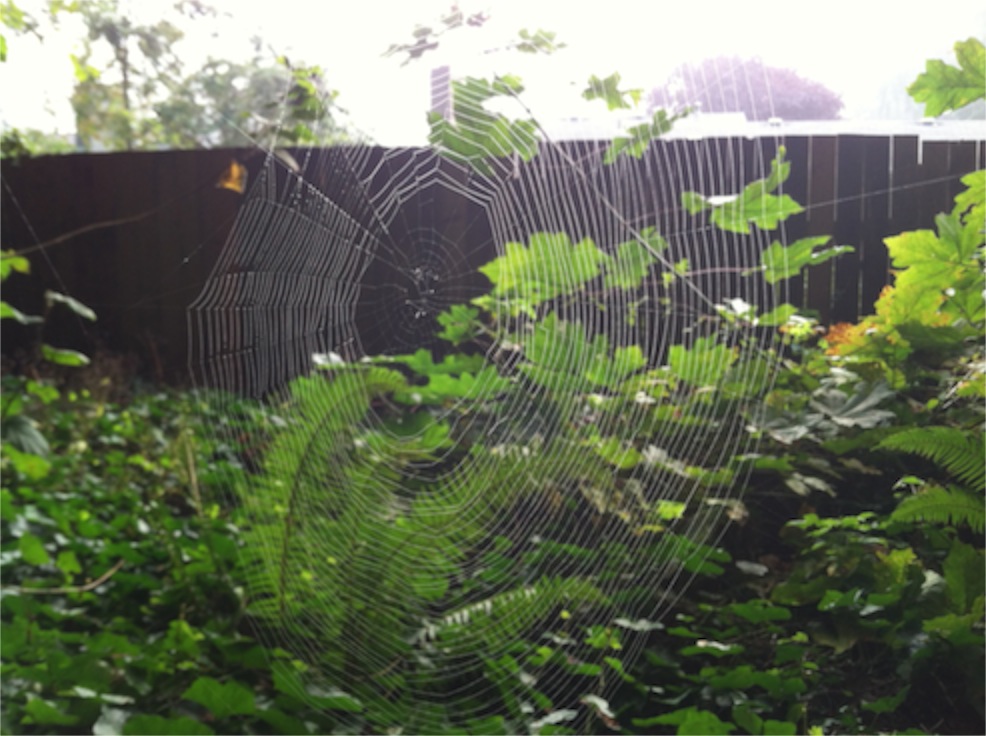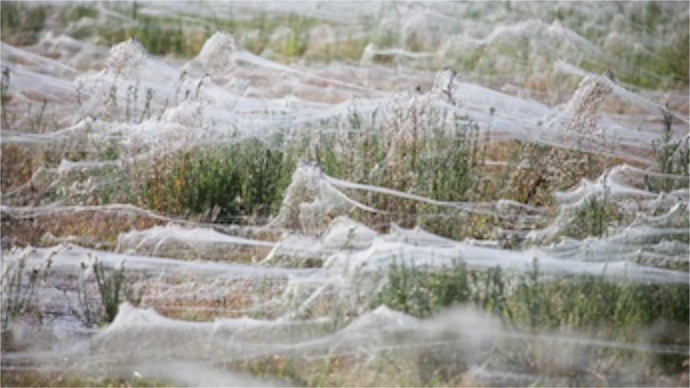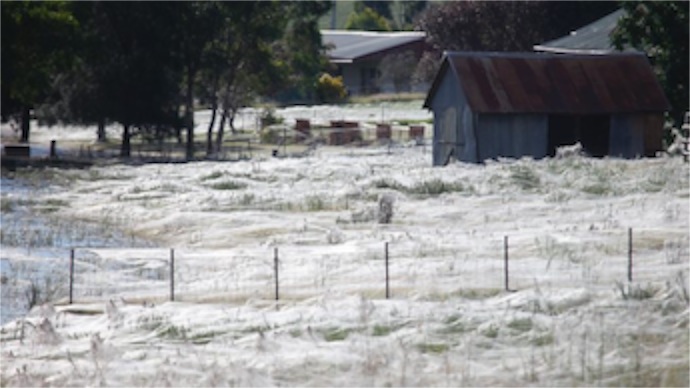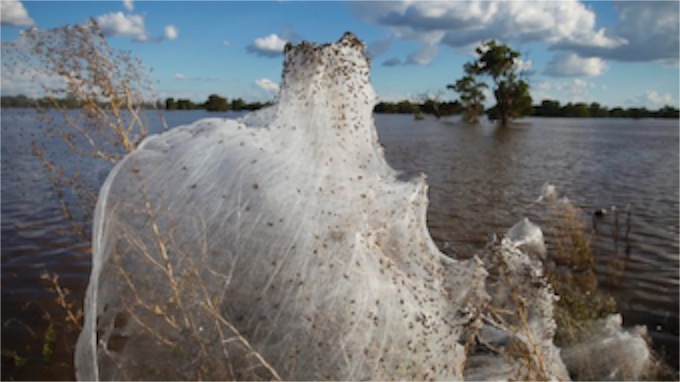Webs of Relationships
07/03/12 05:06
I have been thinking about webs recently. Spiders, of course have their reasons for building webs. Insects become trapped in the webs, providing a food source for the spider. There is archeological evidence of spider webs as old as 140 million years. The silk web material was captured in amber from the early Cretaceous period. Scientists believe that when spiders began to move from the water to the land they started making silk to protect their bodies and eggs. Gradually the silk was used for hunting purposes, first as guide or signal lines, later as ground webs, and eventually as aerial webs.

Spiders save energy by not having to run down their prey. However, the process of making the silk requires a large amount of protein. Some spiders recycle their webs by eating and recycling the protein.
Spider webs are strong. The tensile strength of spider silk is greater than the same weight to steel and is much more elastic. Scientists are working to discover ways to use the material in products as diverse as bulletproof vests and artificial tendons to help people recover after injuries.
But I have been thinking of webs in a different way. I have been thinking of them as a metaphor for the networks of relationships we humans develop. A spider begins by stretching a silk line from one point to another. Then another line is stretched to another point. Multiple lines connect many different objects. Then the spider begins to connect the various lines with other lines until the entire network is so connected that the spider can feel vibration from any point in the network. We connect ourselves in networks of relationships. What happens to another person has an effect on us.
Much attention has been given lately to computer-mediated social networking. People invest incredible amounts of time developing relationships through sites such as Facebook and LinkedIn. I have participated in those and other networking tools, but am also aware of how much time they can take. There is a distance that the computer provides that makes such networking a bit less satisfying than in person relationships. Nonetheless, it is a good way to maintain relationships over large distances. We get to see pictures of friends who live in other countries and keep up with their families in ways that were not practical before.
Spiders, it appears, are more adaptable than we humans.
 Recently, floodwaters forced the evacuation of Wagga Wagga, a town in Australia. The human inhabitants weren’t the only ones who were forced to flee. When the floodwaters swamped the town and surrounding fields, thousands upon thousands of spiders were forced to relocate. The flood triggered what is called a mass ballooning event. The spiders spin a sail of silk and are carried by the wind to another location. When thousands of spiders land in the same place, there is a mass and they all set about spinning new webs. There are fields that have turned white with spider webs topping every bush and stalk of grass. The spiders are harmless to humans, but the numbers can be a bit overwhelming, especially to those who aren’t fond of the creatures in the first place.
Recently, floodwaters forced the evacuation of Wagga Wagga, a town in Australia. The human inhabitants weren’t the only ones who were forced to flee. When the floodwaters swamped the town and surrounding fields, thousands upon thousands of spiders were forced to relocate. The flood triggered what is called a mass ballooning event. The spiders spin a sail of silk and are carried by the wind to another location. When thousands of spiders land in the same place, there is a mass and they all set about spinning new webs. There are fields that have turned white with spider webs topping every bush and stalk of grass. The spiders are harmless to humans, but the numbers can be a bit overwhelming, especially to those who aren’t fond of the creatures in the first place.
Authorities in Australia say that nothing needs to be done. As the waters recede, the spiders will naturally spread out. The concentrations of spiders make them easy prey for birds and other predators. They will also naturally spread out because there are not enough insects to provide food for the mass concentrations of spiders.
 When we have our support networks disrupted, we are much slower to rebuild them. It can take years to establish new relationships and new connections after a major life event changes things for us. And when we build unhealthy networks with destructive relationships, the challenge of creating new networks can be overwhelming.
When we have our support networks disrupted, we are much slower to rebuild them. It can take years to establish new relationships and new connections after a major life event changes things for us. And when we build unhealthy networks with destructive relationships, the challenge of creating new networks can be overwhelming.
Our friend and teacher Ross Snyder spoke of the network of relationships that we carry with us as “ ecology of spirit.” It is a useful term. We are shaped by many different kinds of relationships. Some of them come from reading books and articles and other resources. Some of them come from people in our past who have helped to shape our characters and influence our journeys. Some of them come from people with whom we have entered into covenant and with whom we remain faithful over long periods of time. Some of them come from those who move through our lives, connecting for brief periods of time. Over the years, our ecology becomes larger and more complex. A particular event may have connections with many other points in our ecology without us being consciously aware of how those connections were forged.
Yesterday I had a brief visit with a family in a hospital. An elder was recovering from surgery following a fracture. Other members of the family were sitting with the elder visiting and providing care. After the visit, as I walked through the hospital, I thought of how many times I have met members of this family at the hospital over the years. We have, of course, met in lots of other places as well – in homes, in church, in stores, at various functions around town. But the hospital provides distinct memories of events in our lives. Both of our families have undergone lots of changes over the years. I have participated in multiple funerals of members of their family, and they have seen a few funerals in my family as well.
 We have grown to treasure our relationships. We enjoy seeing each other and we know how much we can count on each other. And we would never have met were it not for the church.
We have grown to treasure our relationships. We enjoy seeing each other and we know how much we can count on each other. And we would never have met were it not for the church.
Maybe, in some ways, we are like the spiders of Wagga Wagga. Much of our lives are spent dispersed in a thousand different locations with meetings appearing to be by chance. But when the floods come – when trouble arises – we come together. Our connections through the ecology of spirit help us to find our center that is not the institution of the church, but rather the common faith we share.
How many times have I sat around some campfire singing, “We are one in the Spirit, we are one in the Lord?” Too many to count. Nonetheless it is true.

Spiders save energy by not having to run down their prey. However, the process of making the silk requires a large amount of protein. Some spiders recycle their webs by eating and recycling the protein.
Spider webs are strong. The tensile strength of spider silk is greater than the same weight to steel and is much more elastic. Scientists are working to discover ways to use the material in products as diverse as bulletproof vests and artificial tendons to help people recover after injuries.
But I have been thinking of webs in a different way. I have been thinking of them as a metaphor for the networks of relationships we humans develop. A spider begins by stretching a silk line from one point to another. Then another line is stretched to another point. Multiple lines connect many different objects. Then the spider begins to connect the various lines with other lines until the entire network is so connected that the spider can feel vibration from any point in the network. We connect ourselves in networks of relationships. What happens to another person has an effect on us.
Much attention has been given lately to computer-mediated social networking. People invest incredible amounts of time developing relationships through sites such as Facebook and LinkedIn. I have participated in those and other networking tools, but am also aware of how much time they can take. There is a distance that the computer provides that makes such networking a bit less satisfying than in person relationships. Nonetheless, it is a good way to maintain relationships over large distances. We get to see pictures of friends who live in other countries and keep up with their families in ways that were not practical before.
Spiders, it appears, are more adaptable than we humans.

Authorities in Australia say that nothing needs to be done. As the waters recede, the spiders will naturally spread out. The concentrations of spiders make them easy prey for birds and other predators. They will also naturally spread out because there are not enough insects to provide food for the mass concentrations of spiders.

Our friend and teacher Ross Snyder spoke of the network of relationships that we carry with us as “ ecology of spirit.” It is a useful term. We are shaped by many different kinds of relationships. Some of them come from reading books and articles and other resources. Some of them come from people in our past who have helped to shape our characters and influence our journeys. Some of them come from people with whom we have entered into covenant and with whom we remain faithful over long periods of time. Some of them come from those who move through our lives, connecting for brief periods of time. Over the years, our ecology becomes larger and more complex. A particular event may have connections with many other points in our ecology without us being consciously aware of how those connections were forged.
Yesterday I had a brief visit with a family in a hospital. An elder was recovering from surgery following a fracture. Other members of the family were sitting with the elder visiting and providing care. After the visit, as I walked through the hospital, I thought of how many times I have met members of this family at the hospital over the years. We have, of course, met in lots of other places as well – in homes, in church, in stores, at various functions around town. But the hospital provides distinct memories of events in our lives. Both of our families have undergone lots of changes over the years. I have participated in multiple funerals of members of their family, and they have seen a few funerals in my family as well.

Maybe, in some ways, we are like the spiders of Wagga Wagga. Much of our lives are spent dispersed in a thousand different locations with meetings appearing to be by chance. But when the floods come – when trouble arises – we come together. Our connections through the ecology of spirit help us to find our center that is not the institution of the church, but rather the common faith we share.
How many times have I sat around some campfire singing, “We are one in the Spirit, we are one in the Lord?” Too many to count. Nonetheless it is true.